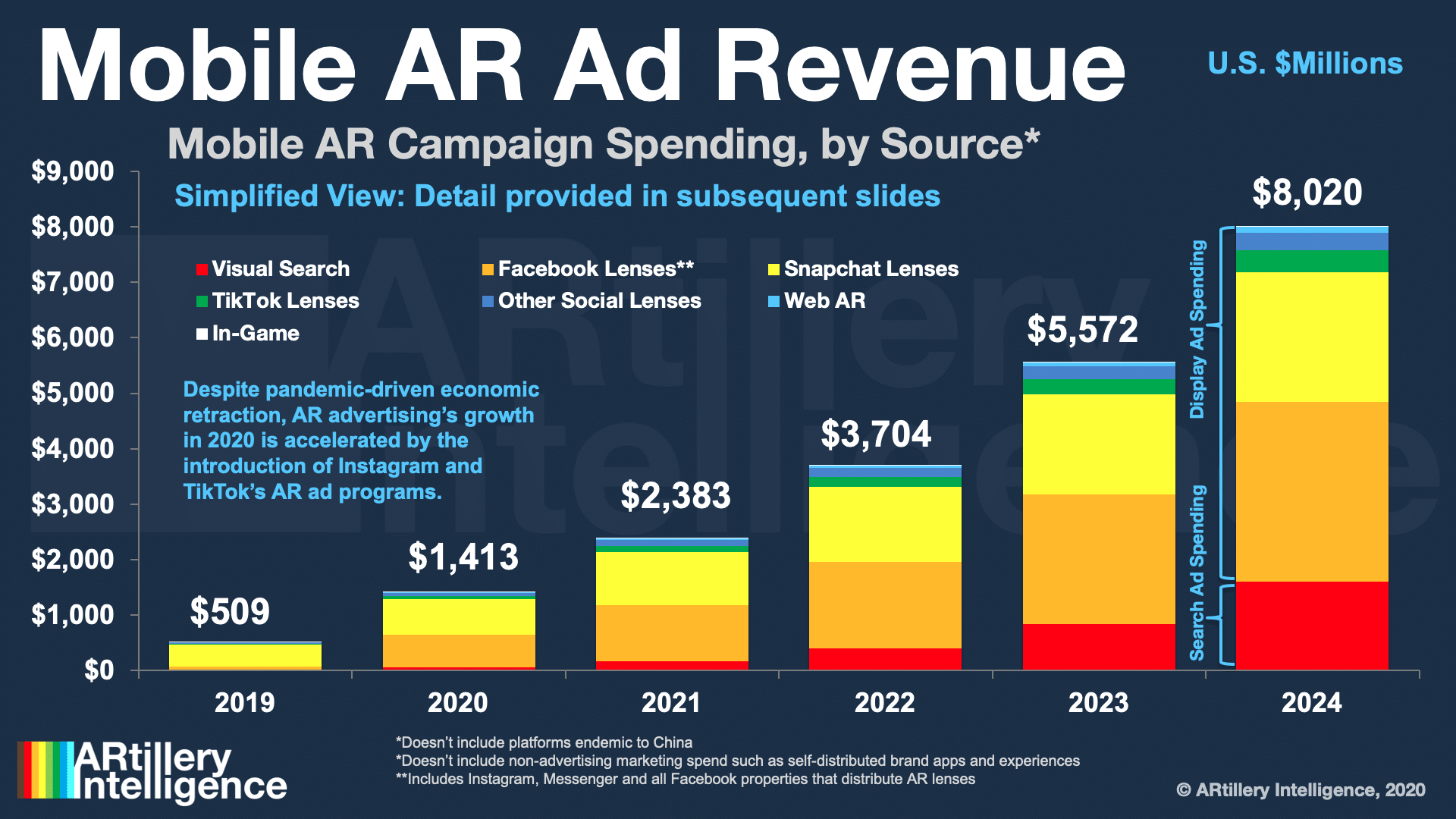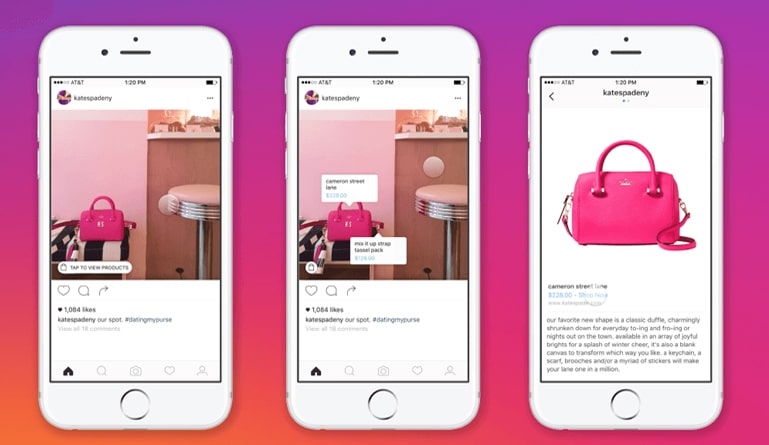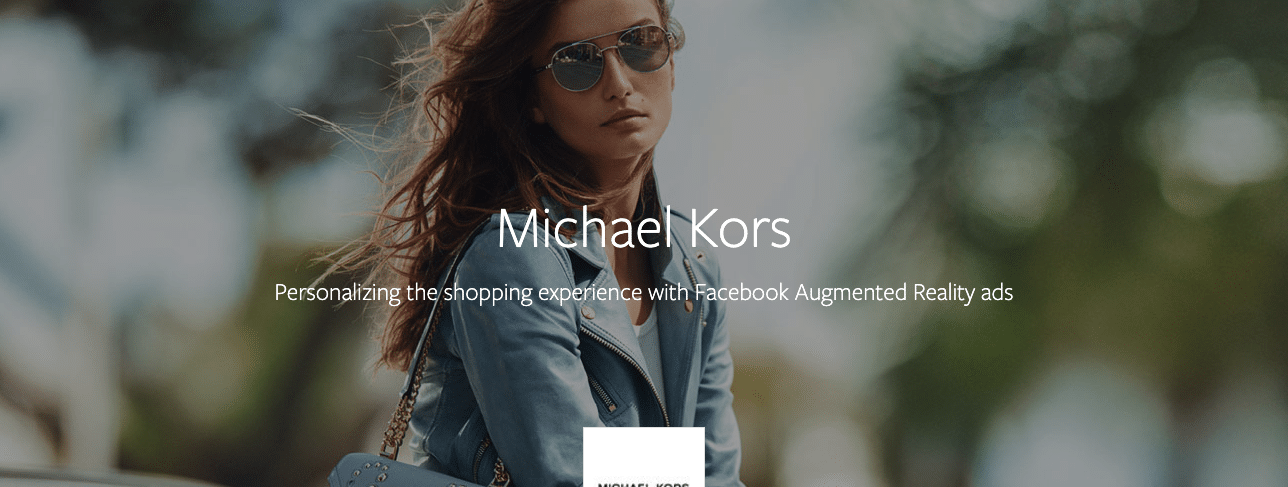
![]() This post is adapted from ARtillery Intelligence’s report, AR Advertising Deep Dive, Part I: The Landscape. It includes some of its data and takeaways. More can be previewed here and subscribe for the full report.
This post is adapted from ARtillery Intelligence’s report, AR Advertising Deep Dive, Part I: The Landscape. It includes some of its data and takeaways. More can be previewed here and subscribe for the full report.
AR continues to evolve and take shape as an industry. Prominent sectors include industrial AR, social, gaming, and shopping. But existing alongside all of them is AR advertising. This includes paid/sponsored AR lenses that let consumers visualize products on “spaces & faces.”
Advertising is one of the most lucrative AR subsectors, on pace to reach $1.41 billion this year and $8.02 billion by 2024. These figures measure the money spent on sponsored AR experiences with paid distribution on networks like Facebook and Snapchat.
As we’ve examined in past reports, the factors propelling this revenue growth include brand advertisers’ growing affinity for AR. Its ability to demonstrate products in immersive ways resonates with their creative sensibilities, transcending what’s possible in 2D formats.
Beyond that high-level appeal, there’s a real business case. AR ad campaigns continue to show strong performance metrics. This was the case in “normal” times and has accelerated during the COVID era when retail lockdowns compel AR’s ability to visualize products remotely.

Doubling Down
Picking up where we left off last week in defining the ins and outs of Snapchat’s AR platform play and developing ad business, it’s time to move on to Facebook. What is the social giant doing to cultivate AR lenses to engage users, and to monetize through brand advertising?
Though Facebook has well-known aspirations for face-worn AR (and VR), it knows the near-term gateway drug is AR that occurs on your smartphone. Fortunately, that’s aligned with the company’s core ad monetization and social-engagement positioning on smartphones.
“Headsets are not quite ready for large-scale consumer adoption,” said Facebook’s Elise XU at AWE Europe. “We want to give developers and creators easy and cheap ways to create things in AR… Mobile is a wonderful gateway into that, and there’s a ton of scale.”

AR also supports Facebook’s core business: advertising built on social engagement. Its primary revenue correlates to the time we spend in its walled garden. AR gives it more ways to keep us there longer through visually immersive – and advertising-conducive – content.
As further background, Facebook’s News Feed ads have grown overcrowded so it’s motivated to innovate new forms of user engagement that represent ad inventory. With its Spark AR platform, it has followed Snapchat’s Lens studio in making AR lenses a currency in social sharing.
The two platforms are similar in lots of ways but differ when it comes to reach and distribution options. Facebook’s possibilities are a bit more varied than Snapchat, given Facebook’s many properties that include News Feed, Messenger, Portal and Instagram.
Viral Kick
For example, Facebook’s flagship News Feed combines reach and audience targeting. That’s been the case for a while with 2D News Feed ads like banners and videos. But now that Spark AR has been brought to the News Feed, it amplifies AR’s potential reach.
Just like regular News Feed ads, AR advertisers can hyper-target lens distribution. But deviating from 2D ads, lenses have greater dimension. From the user’s perspective, he or she can activate the camera directly from those ads to launch a sponsored AR experience.
For example, launch partner Michael Kors built a campaign that lets users quickly go from the News Feed ad to a front-facing camera activation that virtually tries on sunglasses. Videos of those usually-boisterous try-ons can also be shared for an additional viral kick.

The result was a campaign that ran for two weeks and achieved a 14 percent incremental lift in purchases. It also achieved strong upper-funnel branding, including a 20-point lift in ad recall, 5-point lift in favorability and 3.9-point lift in purchase intent.
Importantly, these ads can flow into a transaction. This gets back to the “full-funnel” principle examined earlier in this report — hitting the marks of high reach (News Feed distribution), brand awareness (News Feed banners) and high-intent transactions (AR try-ons).
We’ll pause there and circle back in the next installment to continue the discussion of how Facebook is cultivating lens engagement among users, and monetization among brands. Next, we’ll examine its diversified approach to achieve scale. Check out the full report here.
